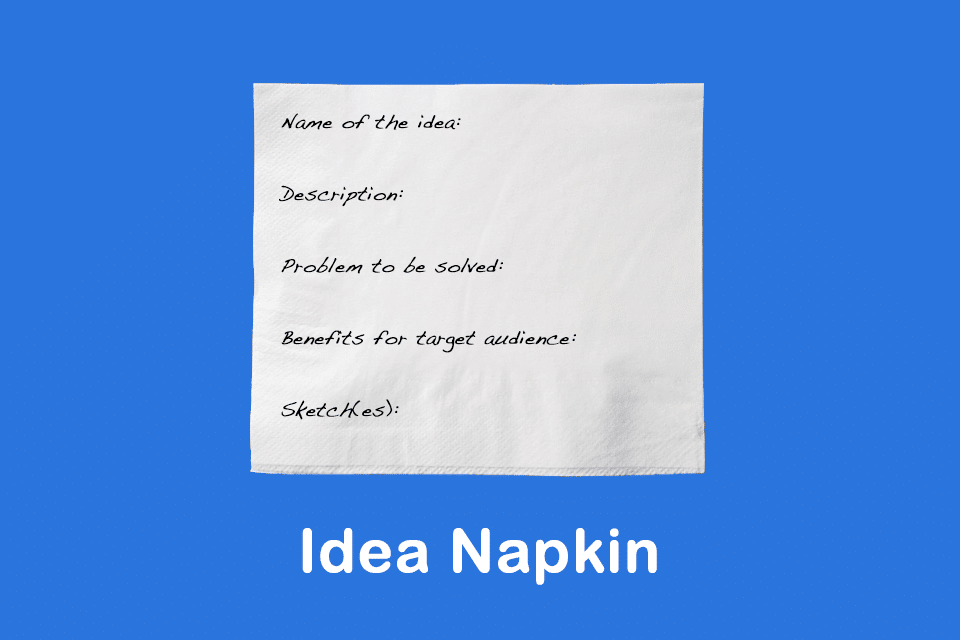What is Idea Napkin?
Smartpedia: Idea Napkin describes an approach to documenting ideas easily and quickly in five steps on a napkin.
Idea Napkin – The quick documentation of ideas
Imagine you are sitting in a restaurant and suddenly you have an idea to solve a problem that has been bothering you for a while. What do you do? You write down the idea. And how do you do that? With a pen and the napkin in front of you. In other words, you use Idea Napkin.
Idea Napkin describes an approach with which you observe five simple aspects when documenting ideas. In fact, it doesn’t matter whether the medium used for documentation is a napkin, a beer mat, a sheet of paper or an app on a smartphone.
Some publications state that Idea Napkin is a written elevator pitch; however, this may be doubted, because an elevator pitch refers to the concise verbal presentation of an idea that is advertised in a lift, according to its name, in order to gain the interest of a decision-maker. Idea Napkin could provide an impulse for an elevator pitch or initially outline the idea that will be pitched at another time. In terms of content, the procedure is probably more akin to so-called brain-netting.¹
The structure of an Idea Napkin
In the course of documenting ideas, there are five simple aspects to consider:
Give the idea a descriptive name.
Ideally, the name should convey briefly and compactly what the idea is about. In practice, it can be observed that ideas with comprehensible names are easier to communicate and the identification of the participants in the discussion with the ideas increases.²
Examples: Optimisation of the form on registration pages. Or: Use of interaction elements in our blog.
Describe the idea briefly and compactly.
Here, Brevity is the soul of wit (which is not surprising, because the entire idea should fit on a napkin); ideally, the description should be no longer than one sentence.
Examples: To increase download numbers, we delete all query fields that are not absolutely necessary for the download. (By the way, we have put this idea into practice for our downloads.) Or: At the end of a blog post, we offer readers the option to click a “thumbs up” to show the number of positive feedbacks.
Explain the problem that the idea addresses.
his is about details of problems or challenges that could be overcome by the new idea. It is also useful to mention possible target audiences and their needs.
Examples: If a development manager lands on the download page for the Clean Code Whitepaper, they often cancel the download when entering their data. The download is a prerequisite for including the prospect in the sales funnel. Or: If a prospect reads an article that is interesting to him, he can draw the attention of other prospects to the article through his feedback via “thumbs up” and the subsequent “sharing of the article”.
Describe how the target audience will benefit from the idea.
This point is important because often ideas “only” address internal problems from which other, relevant groups of people do not benefit. In business practice, it is important to find a sensible measure for ideas that also have an effect in the direction of users or clients.
Examples: By not asking additional questions, we show the prospective customer that it is really only about a download. This increases his/her trust in us and promotes his/her willingness to actually carry out the download. Or: By giving the option to leave one’ s feedback via “thumbs up”, in combination with the option to share the blog post in his/her network, the reader can position himself/herself as a knowledge carrier in his/her network.
Sketch how the idea solves the problem.
The visual sketch helps to present the core of the idea. If it makes sense, it could be created like a user story from the user’s point of view. It should be noted that the quality of the sketch is of course irrelevant, because the focus is not on the artistic realisation, but on aspects such as the user experience, which can be influenced by the arrangement of elements in a software³, the positioning of operating elements in products or the design of work steps in a process.
Since the points themselves are quite easy to implement, opinions exist that advocate the use of Idea Napkins in brainstorming sessions as well. Organisations should find out for themselves whether this makes sense.
Impulse to discuss
Have you defined a format for quick and easy documentation of ideas for yourself personally or within your organisation?
Notes:
[1] As a method or approach, Idea Napkin is often attributed to Design Thinking.
[2] Opinions vary as to whether a significant advantage should already be outlined in the name of the idea. Example: Reduction of input fields in forms for the purpose of higher conversion.
[3] This could already be a rudimentary click dummy.
Here you can download the Ideation Whitepaper free of charge. It explains many more practical methods of idea generation in detail.
If you like the article or would like to discuss it, please feel free to share it in your network. And if you have any comments, please do not hesitate to send us a message.
And here you will find additional information from the t2informatik Blog:



